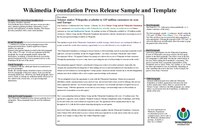
Photo from wikipedia
ABSTRACT On 7 January 2015, brothers Said and Cherif Kouachi, armed with Kalashnikovs, entered the headquarters of the Paris-based satirical magazine, Charlie Hebdo, and opened fire, killing 12 people and… Click to show full abstract
ABSTRACT On 7 January 2015, brothers Said and Cherif Kouachi, armed with Kalashnikovs, entered the headquarters of the Paris-based satirical magazine, Charlie Hebdo, and opened fire, killing 12 people and injuring 11 more. It would later emerge that the brothers – both native Frenchmen born to Algerian parents – belonged to the Islamist terrorist group, al Qaeda. The attack, which targeted a Western magazine, attracted tremendous international news coverage, provoking a widespread debate over issues relating to free speech, immigration (even though both attackers were born in France) and integration. There has been less discussion of the news framing of the attack by Western media outlets, and to what degree that news framing may have been biased or Islamophobic. In this study, it is our goal to understand how media framing may have been affected by this attack, and to what degree such framing is Islamophobic. To that end, we have operationalised the Runnymede framework of Islamophobia using the content analysis software Nvivo, in order to identify and better understand manifestations of Islamophobia in the mainstream press. Specifically, we analyse the news framing of Islam in the headlines of two US daily newspapers, The New York Times and The Wall Street Journal.
Journal Title: Critical Studies on Terrorism
Year Published: 2023
Link to full text (if available)
Share on Social Media: Sign Up to like & get
recommendations!